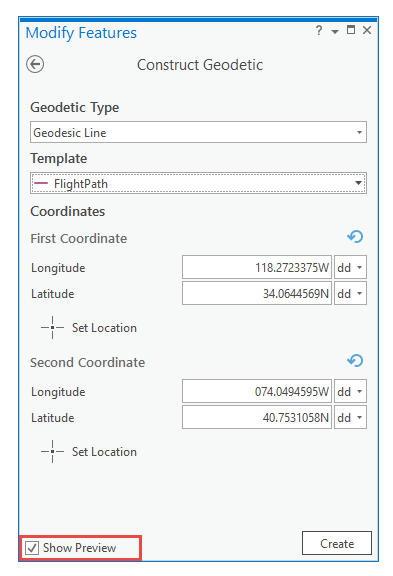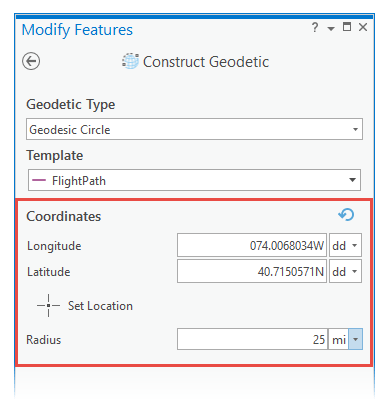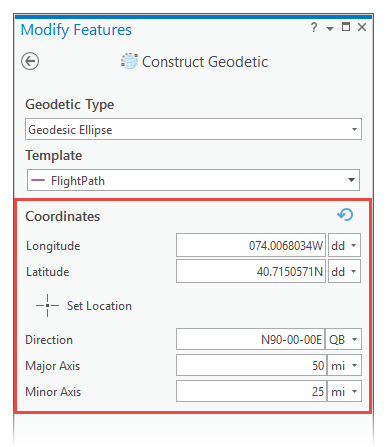The Construct Geodetic tool  creates spatially accurate and geodetically correct densified line and polygon features. You can create geodesic lines, loxodromes, great elliptic paths, geodesic circles, and geodesic ellipses. This tool is available in the Modify Features pane.
creates spatially accurate and geodetically correct densified line and polygon features. You can create geodesic lines, loxodromes, great elliptic paths, geodesic circles, and geodesic ellipses. This tool is available in the Modify Features pane.
Geodetic features account for the inherent distortion caused by projecting a curved line that follows the curvature of the earth onto a flat projected space such as a flight path between two cities.
You can click the map to specify a location or type longitude and latitude coordinate pairs in a chosen format such as a Military Grid Reference System (MGRS) grid location, a U.S. National Grid (USNG) location, or a Universal Transverse Mercator (UTM) coordinates.
To create geodetic line or polygon feature, complete the following steps:
- On the ribbon, click the Edit tab, choose your snapping preferences, and open the Modify Features pane.
- In the Snapping group, click the Snapping drop-down menu
 and enable your snapping preferences.
and enable your snapping preferences. - In the Features group, click Modify
 .
.
- In the Snapping group, click the Snapping drop-down menu
- In the tool pane, expand Construct, and click Construct Geodesic
 .
.- To exit the tool, press Esc.
- To preview the geodesic feature on the map before you create it, check Show Preview.

- Click the Geodetic Type arrow and choose a geodetic feature type.
- Geodesic line—The shortest line between any two locations on a spheroid, for example a flight path between two cities. Also known as the great-circle distance when a spheroid (ellipsoid) is used. You can create this geodetic type only on line feature layers.
- Loxodrome—A line of constant bearing, or azimuth between two locations; not the shortest distance. Also known as a Rhumb line. You can create this geodetic type only on line feature layers.
- Great elliptic—An elliptical arc between two locations defined by a plane passing through the center of the spheroid. Also known as a great-circle distance when a spheroid (ellipsoid) is used. You can create this geodetic type only on line feature layers.
- Geodesic circle—A continuous line with every point on the path radially equidistant from one specified location. Its circular or noncircular shape depends on the coordinate system with which it is projected. You can create this geodetic type on line and polygon feature layers.
- Geodesic ellipse—A continuous line whose sum of geodetic distances from a fixed pair of locations is a constant. You could use this to create a signal error ellipse. This is also known as a geodesic circle when the major and minor axes are the same length. You can create this geodetic type on line and polygon feature layers.
- Click the Template arrow and choose the layer on which to create the feature.
- If you are creating a geodesic line, loxodrome, or great elliptic, specify the first and second coordinate locations.
- To change the unit format, click the units arrow.
- To reset the set location coordinates, click Reset
 .
.
- Type the coordinates for the first location or click Set Location and click the map.
- Type the coordinates for the second location or click Set Location and click the map.
- If you are creating a geodesic circle, specify the center coordinate location.
- To change the unit format, click the units arrow.
- To reset the set location coordinates, click Reset
 .
.
- Type the coordinates for the center location or click Set Location and click the map.
- Type the radius value.

- If you are creating a geodesic ellipse, specify the center coordinate location, direction, major axis, and minor axes.
- To change the unit format, click the units arrow.
- To reset the set location coordinates, click Reset
 .
.
- Type the coordinates for the center location or click Set Location and click the map.
- Type the direction value.
- Type the major axis distance.
- Type the minor axis distance.

- Click Create